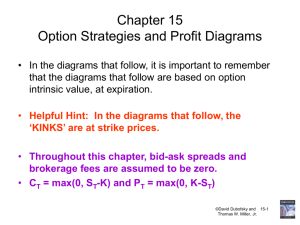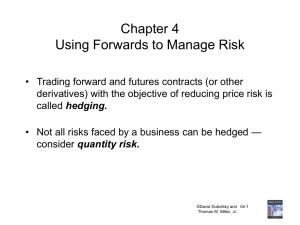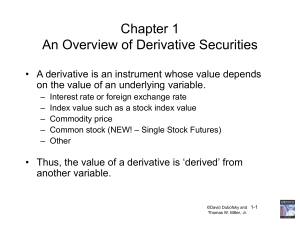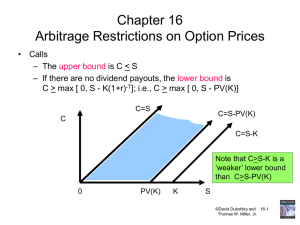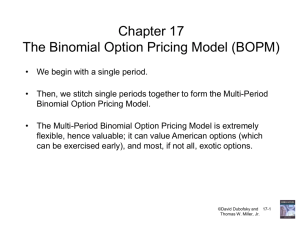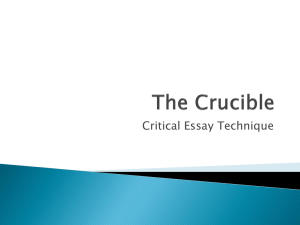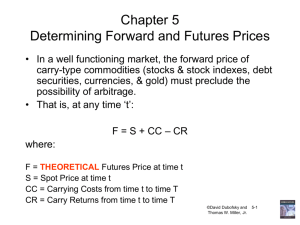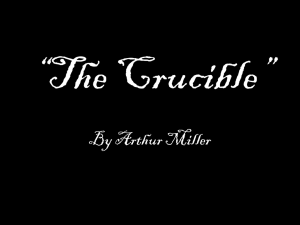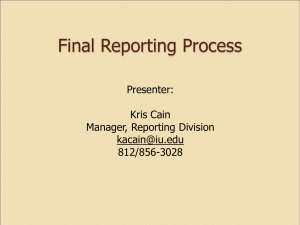Chapter 14
advertisement
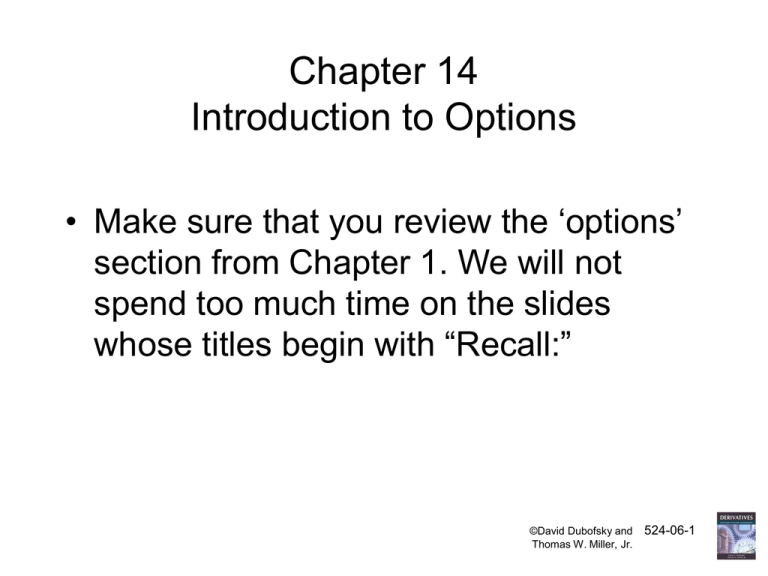
Chapter 14 Introduction to Options • Make sure that you review the ‘options’ section from Chapter 1. We will not spend too much time on the slides whose titles begin with “Recall:” ©David Dubofsky and Thomas W. Miller, Jr. 524-06-1 Recall: Options • Option Contracts Separate Obligations from Rights. • Two basic option types: – Call options – Put options • Two basic option positions: – Long – Short (write) ©David Dubofsky and Thomas W. Miller, Jr. 524-06-2 Recall: Call Option Contracts • A call option is a contract that gives the owner of the call option the right, but not the obligation, to buy an underlying asset, at a fixed price ($K), on (or sometimes before) a pre-specified day, which is known as the expiration day. • The seller of a call option, the call writer, is obligated to deliver, or sell, the underlying asset at a fixed price, on (or sometimes before) expiration day (T). • The fixed price, K, is called the strike price, or the exercise price. • Because they separate rights from obligations, call options have value. • We denote the call premium as “C”. ©David Dubofsky and Thomas W. Miller, Jr. 524-06-3 “Moneyness”: In-the-money, out-of-the-money, and at-the-money • Define S as the price of the underlying asset, and K as the strike price. Then, for a call: – – – – – In-the-money, if S > K Out-of-the-money, if S < K At-the-money, if S ~ K Deep-in-the-money, if S >> K Deep-out-of-the-money, if S << K ©David Dubofsky and Thomas W. Miller, Jr. 524-06-4 Intrinsic Value and Time Value • Intrinsic value of a call = max(0, S-K) – (You read this as: “The maximum of: zero OR the stock price minus the strike price.”) • Time value = C - intrinsic value • Time value declines as the expiration date approaches. At expiration, time value = 0. ©David Dubofsky and Thomas W. Miller, Jr. 524-06-5 Example: Intrinsic Value for a Call • Suppose a call option is selling for $1.70. The underlying asset price is $41.12. – Consider a call with a strike price of 40. Is this call in the money or out of the money? Calculate the intrinsic value of this call. What is the time value? – Consider a call with a strike price of 45. Is this call in the money or out of the money? Calculate the intrinsic value of this call. What is the time value? ©David Dubofsky and Thomas W. Miller, Jr. 524-06-6 Recall: Payoff Diagram for a Long Call Position, at Expiration Expiration Day Value 45o 0 ST K ©David Dubofsky and Thomas W. Miller, Jr. 524-06-7 Recall: Profit Diagram for a Long Call Position, at Expiration We lower the payoff diagram by the call price (or premium), to get the profit diagram Profit 0 call premium K ST ©David Dubofsky and Thomas W. Miller, Jr. 524-06-8 Recall: Profit Diagram for a Short Call Position, at Expiration Profit 0 Call premium S K T ©David Dubofsky and Thomas W. Miller, Jr. 524-06-9 Recall: Put Option Contracts • A put option is a contract that gives the owner of the put option the right, but not the obligation, to sell an underlying asset, at a fixed price, on (or sometimes before) a pre-specified day, which is known as the expiration day (T). • The seller of a put option, the put writer, is obligated to take delivery, or buy, the underlying asset at a fixed price ($K), on (or sometimes before) expiration day. • The fixed price, K, is called the strike price, or the exercise price. • Because they separate rights from obligations, put options have value. • The put premium is denoted “P”. ©David Dubofsky and Thomas W. Miller, Jr. 524-06-10 Put Option “Moneyness” • Define S as the price of the underlying asset, and K as the strike price. • Then, for a put option: – – – – – In-the-money, if K > S Out-of-the-money, if K < S At-the-money, if K ~ S Deep-in-the-money, if K >> S Deep-out-of-the-money, if K << S • Intrinsic value of a put = max(0, K-S) • Time value = P - intrinsic value ©David Dubofsky and Thomas W. Miller, Jr. 524-06-11 Example: Intrinsic Value for a Put • Suppose a put option is selling for $5.70. The underlying asset price is $41.12. – Consider a put with a strike price of 40. Is this put in the money or out of the money? Calculate the intrinsic value of this put. What is its time value? – If the put has a strike price of 45, then is it in the money or out of the money? Calculate the intrinsic value of a put with a strike price of 45. What is its time value? ©David Dubofsky and Thomas W. Miller, Jr. 524-06-12 Recall: Payoff diagram for a long put position, at expiration K Value on Expiration Day 0 S K T ©David Dubofsky and Thomas W. Miller, Jr. 524-06-13 Recall: Profit Diagram for a Long Put Position, at Expiration Profit Lower the payoff diagram by the put price, or put premium, to get the profit diagram 0 K put premium ©David Dubofsky and Thomas W. Miller, Jr. S T 524-06-14 Recall: Profit Diagram for a Short Put Position, at Expiration Profit 0 K S T ©David Dubofsky and Thomas W. Miller, Jr. 524-06-15 Let K=50; P=4 Intrinsic Value of Put 10 9 8 7 6 5 4 3 2 1 0 0 0 0 0 0 0 0 0 0 0 Cost of Put Option 4 4 4 4 4 4 4 4 4 4 4 4 4 4 4 4 4 4 4 4 4 Position Profit 6 5 4 3 2 1 0 -1 -2 -3 -4 -4 -4 -4 -4 -4 -4 -4 -4 -4 -4 Long Put Profit Profile, Put Price $4 and Strike Price $50 8 6 4 Put Value Stock Price at Expiration 40 41 42 43 44 45 46 47 48 49 50 51 52 53 54 55 56 57 58 59 60 2 0 -2 -4 -6 40 42 44 46 48 50 52 54 56 Stock Price at Expiration ©David Dubofsky and Thomas W. Miller, Jr. 524-06-16 58 60 Call Pricing Prior to Expiration 14 12 10 8 C Series1 Series2 Series3 6 4 2 0 30 35 40 45 50 55 60 S ©David Dubofsky and Thomas W. Miller, Jr. 524-06-17 Put Pricing Prior to Expiration 16 14 12 P 10 S eries1 8 S eries2 6 S eries3 4 2 0 20 25 30 35 40 S 45 50 55 ©David Dubofsky and Thomas W. Miller, Jr. 524-06-18 Comparative Statics All else equal: Call values rise as – – – – – S rises lower K longer T higher volatility higher r Puts rise as - S falls - higher K - ????? - higher volatility - lower r • American put values rise with a longer T • European put values are indeterminate with respect to T ©David Dubofsky and Thomas W. Miller, Jr. 524-06-19 Reading Option Price Data • See WSJ, and http://quote.cboe.com/QuoteTable.asp • Options on individual stocks – Leaps • Index options (& leaps) • Futures Options • FX Options (see http://www.phlx.com/products/currency.html) ©David Dubofsky and Thomas W. Miller, Jr. 524-06-20 Index Options • Most index options are European. • Index options are cash settled. – At expiration, the owner of an in the money call receives 100 X (ST – K) from the option writer. – At expiration, the owner of an in the money put receives 100 X (K – ST) from the option writer. – Equivalently, the option owner receives its intrinsic value on the expiration day. ©David Dubofsky and Thomas W. Miller, Jr. 524-06-21 Futures Options • The owner of a call on a futures contract has the right to go long a futures contract at the strike price. • The exerciser of a call on a futures contract goes long the futures contract, which is immediately marked to market (he receives F – K). The writer of that call must pay the intrinsic value and either a) deliver the futures contract he owns, or b) go short the futures contract. • The exerciser of a put on a futures contract goes short the futures contract, which is immediately marked to market (she receives K – F). The writer of that put must pay the put’s intrinsic value and either a) has the obligation to assume a long position in the futures contract, or b) if she was short the futures to begin with, she will see her futures position offset. ©David Dubofsky and Thomas W. Miller, Jr. 524-06-22 Other Interesting Options • Flex Options (http://www.cboe.com/Institutional/Flex.asp) • Interest Rate Options (mostly OTC, but see Barrons, and http://www.cboe.com/OptProd/understanding_products.as p#irate and http://www.cboe.com/common/pageviewer.asp?sec=4&dir =opprodspec&file=i-rateop.doc Ticker symbols are IRX, FVX, TNX, and TYX) • Exotic Options; see chapter 20 – Asian Options (C(T) = S(AVG) - K) – Lookback Options (C(T) = S(T) - MIN(S)) – Chooser options (ChO(T) = max (c,p)) – Etc. • Swaptions (section 20.2.5) ©David Dubofsky and Thomas W. Miller, Jr. 524-06-23
